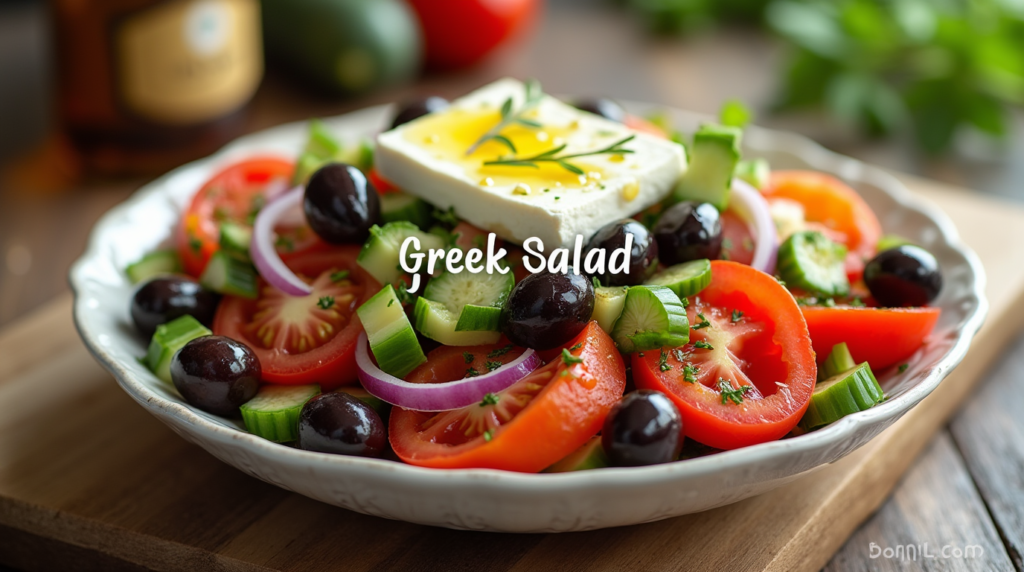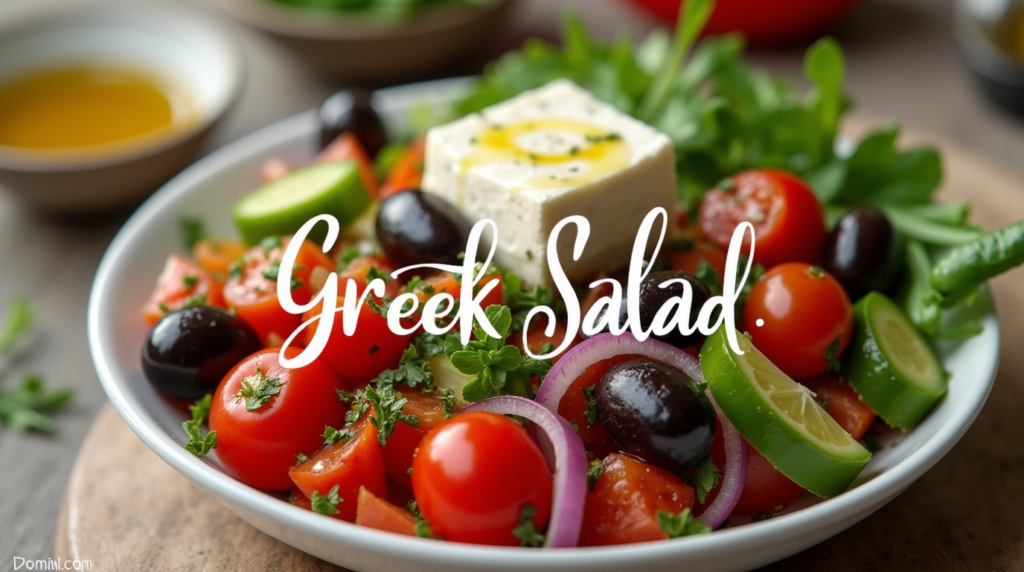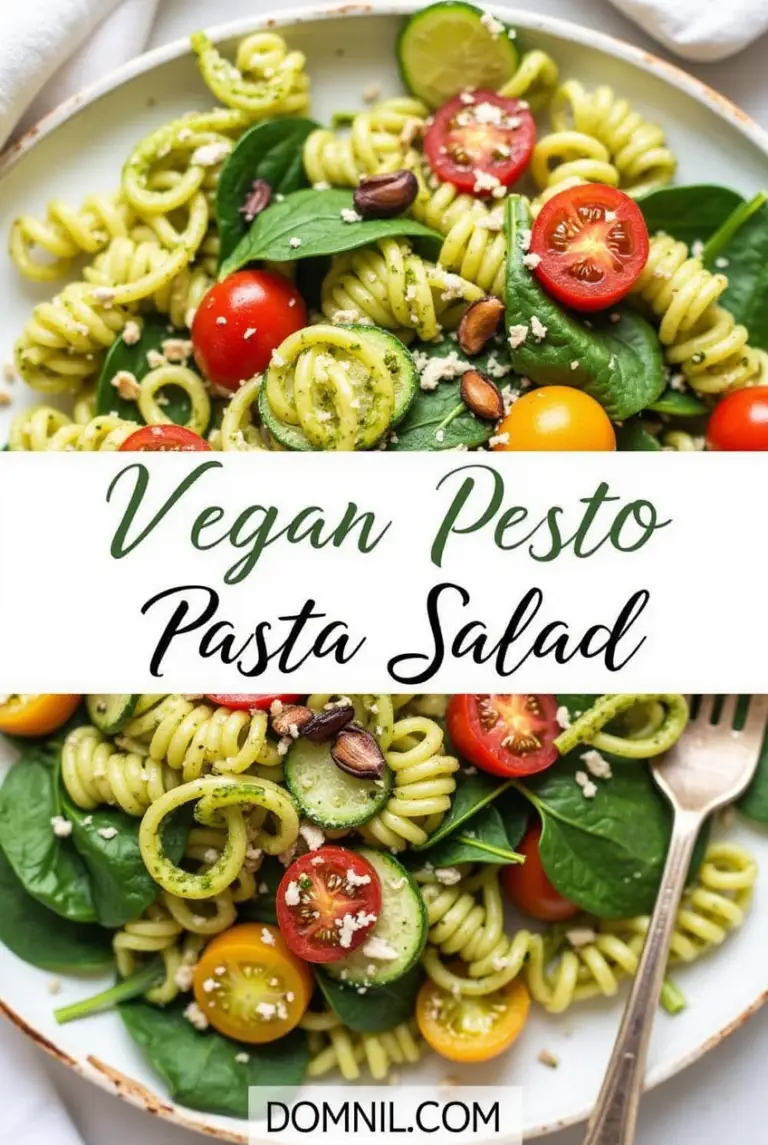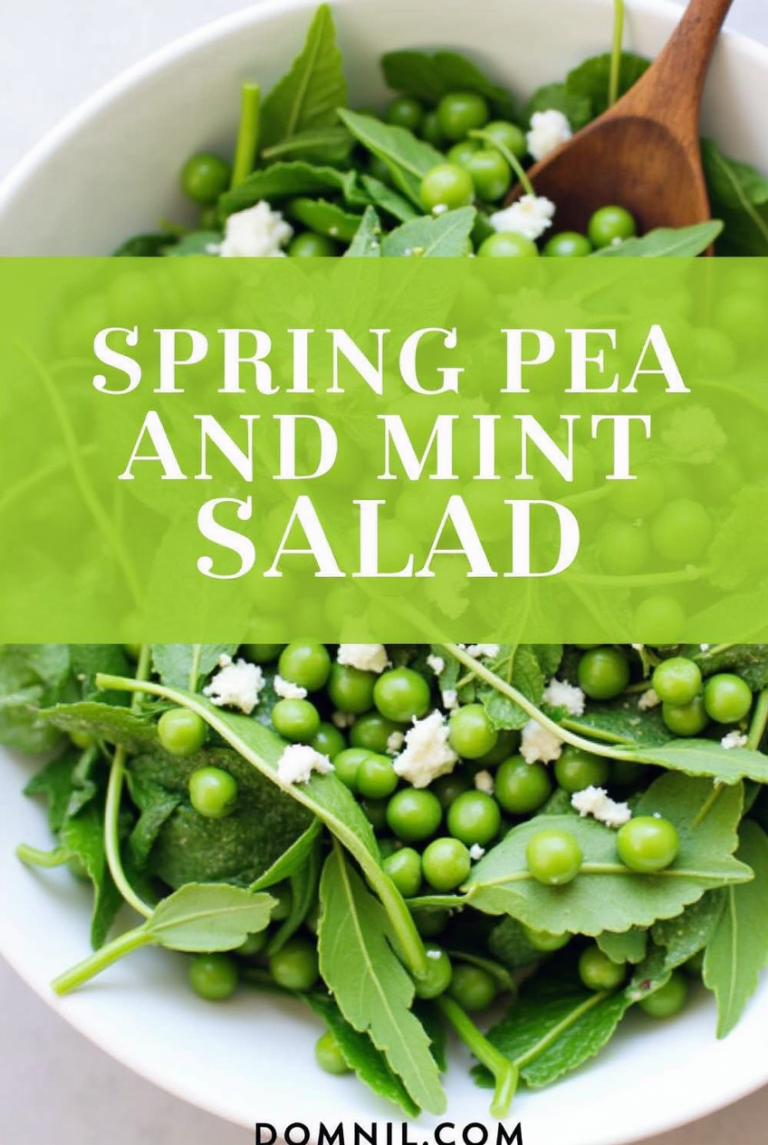Authentic Greek Salad Recipe
Introduction to Greek Salad
The History Behind Greek Salad
Greek salad, known in Greece as “Horiatiki” (which means “village salad”), isn’t just a dish—it’s a piece of Mediterranean heritage that’s deeply rooted in simplicity, tradition, and fresh produce. It emerged as a staple during the 19th and 20th centuries when rural Greek communities relied on locally grown vegetables and cheese to create quick yet nourishing meals. This wasn’t something made for fancy gatherings—it was rustic, humble, and made from what was growing in the garden or bought fresh at the local open market.
Back then, refrigeration wasn’t an option, and processed food wasn’t a thing, so meals had to be fresh and quick. The original Greek salad came about from these exact necessities. Tomatoes just picked from the vine, cucumbers that still had morning dew on them, and salty, creamy blocks of feta cheese made directly from goat or sheep’s milk—this was the foundation.
You’ll be surprised to know that the traditional Greek salad doesn’t even use lettuce, a common Western addition. And forget any creamy dressing—there’s no ranch or Caesar in sight. Just a drizzle of olive oil, maybe a splash of vinegar, and herbs straight from the Mediterranean hillsides like oregano.

Table of Contents
Cultural Significance in Greek Cuisine
In Greece, meals are meant to be shared. The Greek salad often plays the role of a centerpiece, surrounded by other small dishes like grilled meats, fresh bread, dips like tzatziki, and perhaps a few glasses of ouzo or wine. It’s not just about taste—it’s about community. Sitting at a long table outdoors, the sun overhead, the sea breeze blowing through—this is the setting in which the Greek salad shines the brightest.
The salad is more than a starter; it’s a symbol of hospitality and lifestyle. Greek people embrace the concept of “filoxenia” — the love for strangers — and food is the bridge that connects them. When you serve an authentic Greek salad, you’re not just offering food; you’re offering an invitation to connect, to slow down, and to savor life.
What Makes a Greek Salad Truly Authentic?
Key Characteristics of a Traditional Greek Salad
If there’s one thing you need to know about making an authentic Greek salad, it’s this: keep it simple. Authentic Greek salads are unpretentious and composed of a short list of top-tier ingredients. There’s no tossing involved like in Western-style salads. Instead, the ingredients are layered or arranged so each bite lets you taste the purity of the produce.
Here are the non-negotiables:
- No lettuce, spinach, or other leafy greens.
- Large chunks of tomato and cucumber—not diced or shredded.
- A generous slab (not crumbles!) of feta cheese on top.
- Pitted or whole Kalamata olives.
- Thinly sliced red onions.
- A sprinkle of dried oregano and a generous drizzle of extra virgin olive oil.
That’s it. Sometimes you might see capers or green bell peppers, but the above ingredients form the holy grail of Greek salad making.
Differences Between Authentic and Western Versions
Westernized versions of the Greek salad often stray far from the original concept. They might include lettuce, which waters down the bold flavors. You might also find them swimming in heavy dressings or topped with non-traditional ingredients like grilled chicken, avocado, or croutons. While tasty, these aren’t Greek in any traditional sense.
One major visual clue: if the feta is cubed and scattered, it’s probably not authentic. In Greece, feta is served in a thick, rectangular slice placed on top—bold and proud. It’s a nod to minimalism and also a way to preserve its texture until mixed at the table.
In short, the authentic version respects the identity of each ingredient. It celebrates them instead of hiding them under sauces or spices. That’s the Mediterranean way.
Essential Ingredients of a Greek Salad
Fresh Vegetables – The Foundation
Tomatoes and cucumbers are the stars here. You want ripe, juicy tomatoes—preferably vine-ripened or heirloom varieties if you can find them. They should be sweet, slightly acidic, and bursting with juice. Don’t refrigerate them before slicing; cold tomatoes lose flavor.
Cucumbers should be crisp and refreshing. Look for seedless or Persian varieties for the best texture. They add the crunch that balances the juiciness of the tomatoes.
Red onions add a pungent, zesty kick. Thin slices are key—they should be sharp but not overpowering. If you’re sensitive to the raw flavor, soak them in cold water for 10–15 minutes to mellow them out without losing their edge.
Green bell peppers are often added for an extra pop of color and a subtle bite. They’re totally optional but widely used in Greece, especially in tavernas near the coast.
The important takeaway: everything needs to be fresh. No wilting, no soft spots, no shortcuts.
Feta Cheese – A Greek Staple
Feta is the queen of this dish, no question about it. Made traditionally from sheep’s milk or a mix of sheep and goat milk, Greek feta is crumbly, tangy, and just the right amount of salty. The texture should be firm but creamy, not rubbery or dry.
What makes feta so special in Greek salad is how it contrasts the vegetables. Every forkful gives you crunch from the cucumber, juiciness from the tomato, and that rich creaminess from the cheese. And remember—it’s served as a block, not crumbled. This isn’t just aesthetic. It keeps the cheese fresh until it’s cut into, allowing you to taste it at its fullest.
If you’re buying feta from the store, check the label. It should be labeled “PDO” (Protected Designation of Origin), which means it’s authentically Greek. Skip anything made from cow’s milk—it’s just not the same.
Kalamata Olives – Mediterranean Flavor Explosion
These olives bring a bold, briny punch that balances the sweet and sour notes of the vegetables. Originating from the Kalamata region in southern Greece, they’re almond-shaped, deep purple, and have a rich, meaty texture.
They’re often added whole with pits intact, which is a testament to their authenticity. Pre-sliced or pitted versions are convenient but often lose flavor during processing. If you don’t like biting into pits, just warn your guests or pit them yourself right before serving.
The olives provide that umami element, that salty-sour balance, and elevate the salad from a basic veggie mix to a complex flavor bomb.

Extra Virgin Olive Oil – The Liquid Gold
If Greek salad had a soul, it would be extra virgin olive oil. This golden nectar is what brings everything together, making it more than just a bowl of chopped veggies. A high-quality olive oil doesn’t just coat the ingredients—it enhances them. The peppery, fruity notes complement the acidity of tomatoes, the brine of olives, and the creaminess of feta in a way no other oil can.
Now, not all olive oils are created equal. When shopping, look for extra virgin on the label, cold-pressed, and ideally, sourced from Greece. Greek olive oil has a distinct flavor profile—smooth with a slight bitterness and a rich, green aroma that pairs beautifully with the salad’s ingredients.
Avoid using light or refined olive oil. These are stripped of the flavor and nutrients that make olive oil special in the first place. Think of olive oil as both a flavor and a dressing. You don’t need to drown the salad—just a generous drizzle is enough. Some purists even pour a bit extra over their bread and swipe it through the leftover salad juices at the end.
Ingredient Selection and Preparation Tips
Choosing the Best Produce
Making an unforgettable Greek salad starts long before you chop your first tomato. It starts at the market. You want tomatoes that feel heavy for their size, with a strong tomato smell at the stem. If it smells like a tomato, it tastes like one too. Avoid any that are too soft or overly firm—they should have just a slight give when pressed.
When it comes to cucumbers, pick the ones that are firm, evenly green, and blemish-free. Avoid waxed cucumbers unless you plan to peel them. Seedless or mini cucumbers offer the best crunch and fewer watery seeds.
Bell peppers should be glossy, firm, and heavy. Green ones are traditional in Greek salad, but red or yellow can also be used if you want a touch of sweetness.
Red onions should have tight, dry skins with no soft spots. When sliced, they should be crisp and pungent—not mushy or sweet-smelling.
Sourcing High-Quality Feta and Olives
As for feta, skip the pre-packaged crumbles in plastic tubs. Go for blocks stored in brine. They’re usually found in the deli section or a specialty cheese counter. Always check that it’s made from sheep’s milk or a mix of sheep and goat milk for authentic taste and texture.
Kalamata olives should also be purchased whole, unpitted if possible, and stored in brine—not oil. The flavor is deeper, saltier, and more authentic. If you’re buying from an olive bar, do a quick taste test if allowed.
Your ingredient list might be short, but that’s why quality matters even more. Think of it like assembling a rock band—you don’t need 10 guitarists; you need four musicians who absolutely kill it at their parts. The same goes for Greek salad.
Step-by-Step Guide to Making Authentic Greek Salad
Tools and Utensils You’ll Need
You don’t need fancy kitchen gadgets to make this salad—just the basics. Here’s what you’ll need:
- A sharp chef’s knife for slicing veggies cleanly.
- A large cutting board.
- A big salad bowl or serving platter.
- A small mixing bowl for making a simple vinaigrette (optional).
- Tongs or salad forks for serving.
A traditional Greek salad is often served in shallow bowls or on flat plates rather than deep salad bowls. This lets you see all the beautiful colors and textures—and makes it easier to scoop up the good stuff.
Preparing the Vegetables Properly
Start by washing all your vegetables under cold water and drying them thoroughly. Any leftover water can dilute the flavor and make your salad soggy.
- Tomatoes: Cut into large wedges or thick chunks. If your tomatoes are particularly juicy, consider removing some of the seeds.
- Cucumbers: Peel if the skin is tough, then slice into thick half-moons or chunks. Don’t make them too thin—they should hold their crunch.
- Onions: Peel and slice thinly into rings or half-rings. Soak in cold water if needed.
- Bell Peppers: Core them and slice into rings or strips.
Lay out the vegetables directly in the serving dish. You’re not tossing them like in a Western salad. Instead, arrange them artfully so that the colors and textures shine through.
Assembling the Salad
Once the vegetables are prepped and in the bowl or platter:
- Add a handful of whole Kalamata olives.
- Place a large slab of feta cheese directly on top—no crumbles!
- Sprinkle dried oregano over the feta and salad.
- Drizzle generously with extra virgin olive oil.
- Add a tiny splash of red wine vinegar (optional) for a tangy note.
- Finish with a pinch of sea salt—just a bit, since the feta and olives already bring the saltiness.
Do not mix it! The idea is that each person takes from the platter and gets a little bit of everything. The salad almost becomes interactive, encouraging conversation and shared enjoyment.
Variations and Regional Twists
Island-Style Greek Salad
Depending on where you are in Greece, your salad might look a little different. On islands like Santorini or Crete, you might find local variations that include capers, barley rusks (paximadia), or regional cheeses like mizithra. These ingredients add new textures and flavors without straying too far from the original formula.
In Santorini, for instance, cherry tomatoes are often used because of the island’s volcanic soil and dry climate, which gives them an intense, almost candy-like flavor. These small tomatoes pack a punch and work beautifully in salads.
Cretan versions might include slices of dakos—a twice-baked barley bread soaked slightly with tomato juice and olive oil. It turns slightly soft under the salad but still has a crunch, acting like a natural crouton.
Rural Village Versions
In smaller villages, the salad might be even more rustic—tomatoes picked minutes before being served, homemade feta, and olive oil pressed from the family’s own olive trees. Some might even add boiled eggs or leftover grilled vegetables, depending on what’s available.
These variations are not deviations but evolutions. They show how adaptable the Greek salad is while staying true to its essence—fresh, local, seasonal, and simple.
Common Mistakes to Avoid
Overcomplicating the Recipe
The biggest mistake you can make is trying to “improve” the salad with too many extras. Authentic Greek salad doesn’t need avocado, bacon, grilled chicken, or fancy dressing. It doesn’t need a dozen spices or herbs either. Less is more.
Another common pitfall is tossing the salad like a garden mix. Greek salad isn’t tossed—it’s layered and served as-is. This preserves the integrity and presentation of each ingredient. It’s meant to be deconstructed with each forkful, not pre-mixed.
Substituting Core Ingredients
Swapping feta for mozzarella, olive oil for vegetable oil, or skipping the olives altogether changes the dish completely. Sure, you can make a delicious salad with those swaps—but it’s no longer a Greek salad.
Stick to the real ingredients whenever possible. Authenticity is about honoring tradition, and Greek salad is one of those dishes where sticking to the rules truly pays off in flavor and experience.
Nutritional Benefits of Greek Salad
A Healthy, Balanced Dish
Greek salad isn’t just delicious—it’s a nutritional powerhouse that supports a healthy lifestyle. Packed with vitamins, minerals, and antioxidants, this salad makes clean eating feel indulgent. Let’s break it down.
Tomatoes bring in a hefty dose of vitamin C, potassium, folate, and lycopene—a powerful antioxidant that may help lower the risk of heart disease and certain cancers. Cucumbers add hydration and fiber with barely any calories, making them perfect for digestion and weight control.
Red onions provide vitamin C and flavonoids that support immune health and fight inflammation. Green bell peppers offer more vitamin C per gram than oranges—yes, really!—along with vitamin A and potassium.
Now, let’s talk about feta. Yes, it’s cheese. Yes, it has fat. But it’s rich in protein, calcium, and probiotics that are good for gut health. Made from sheep or goat milk, it’s also easier to digest than cow’s milk cheese for many people.
Kalamata olives contribute healthy fats, especially monounsaturated fats, which are key to heart health. And let’s not forget extra virgin olive oil—it’s basically liquid gold when it comes to nutrition. Full of antioxidants and anti-inflammatory compounds, it’s been linked to reduced risk of chronic diseases like type 2 diabetes, Alzheimer’s, and even cancer.
The best part? There’s no added sugar, no heavy creams, and zero processed ingredients. Everything comes straight from nature.
Low-Carb and Mediterranean Diet-Friendly
If you’re following a low-carb, keto, or Mediterranean diet, Greek salad fits right in. It’s naturally low in carbs and high in healthy fats and fiber. Plus, the Mediterranean diet isn’t just a fad—it’s backed by decades of scientific research showing its effectiveness in promoting long-term health, especially heart health.
Greek salad helps keep you full without feeling heavy, and it doesn’t spike your blood sugar. That’s a win-win for anyone trying to stay energized and nourished throughout the day.
| Tool/Utensil | Purpose |
|---|---|
| Chef’s Knife | For chopping tomatoes, cucumbers, onions, and bell peppers |
| Cutting Board | Safe surface for slicing and chopping vegetables |
| Mixing Bowl | To prepare and briefly mix ingredients (optional) |
| Serving Platter/Bowl | For arranging and presenting the salad |
| Salad Tongs/Forks | To serve the salad without breaking ingredients |
| Small Bowl/Jar | For mixing olive oil and vinegar (if using as a dressing) |
| Vegetable Peeler | Optional—for peeling cucumbers if preferred |
| Measuring Spoons | To accurately portion olive oil, vinegar, or oregano |
| Colander/Strainer | For rinsing vegetables like tomatoes and cucumbers |
| Storage Containers | To store leftovers or pre-chopped ingredients |

Serving Suggestions
Best Dishes to Pair With Greek Salad
While Greek salad can easily hold its own as a light lunch or side, it pairs wonderfully with a wide range of dishes. Here are a few favorites:
- Grilled meats: Lamb chops, chicken souvlaki, or pork skewers are a match made in heaven. The smokiness of grilled meat and the freshness of the salad create perfect balance.
- Seafood: Try it with grilled shrimp, calamari, or even baked fish like sea bass or salmon. The briny olives and fresh vegetables cut through the richness of the seafood beautifully.
- Spanakopita or Tiropita: These flaky Greek pies filled with spinach and feta (spanakopita) or just cheese (tiropita) are a great complement.
- Lentil or bean dishes: A hearty Greek lentil soup (fakes) or gigantes (giant beans in tomato sauce) make for a fiber-packed duo.
Want to keep it super traditional? Serve with warm, crusty bread to mop up the olive oil and tomato juices left on the plate. It’s an experience you won’t want to miss.
Ideal Occasions to Serve It
Greek salad is versatile enough to serve any time, but some occasions really let it shine:
- Summer BBQs: It’s cool, refreshing, and easy to prep in advance.
- Picnics: Just pack it in a container and go—no wilting lettuce to worry about!
- Holiday feasts: It brings balance to heavier dishes like roasted meats or creamy casseroles.
- Weeknight dinners: Quick, healthy, and satisfying, it’s ideal for busy nights when you want something delicious but effortless.
It also makes a stunning first course for a Mediterranean-themed dinner party. Just imagine setting the table with a few mezze plates, some hummus, and a big beautiful Greek salad in the center. Pure magic.
How to Store Leftover Greek Salad
Storage Tips to Maintain Freshness
Let’s face it—Greek salad is best enjoyed fresh. The vibrant crunch of the vegetables and the richness of the olive oil and feta are at their peak right after making it. But if you do have leftovers, don’t worry—there are smart ways to store them and keep them tasting great.
First, if you anticipate having leftovers, store the feta cheese separately. That helps prevent it from becoming overly salty or mushy when mixed with tomato juice over time.
Transfer the salad to an airtight container and refrigerate it. If your feta was served as a block on top, place it in a small container with a bit of brine or olive oil to keep it from drying out.
Avoid freezing Greek salad. The water content in the vegetables makes them soggy and unappetizing after thawing. Instead, keep it cold and eat it within a day or two.
How Long It Lasts in the Fridge
Properly stored, Greek salad will keep in the fridge for about 2 days. However, the textures start to change after 24 hours. The cucumbers lose their crispness, and the tomatoes release more juice, which can water down the overall flavor.
If you’re meal prepping, keep ingredients like cucumbers, tomatoes, and onions chopped and stored separately. Combine them just before eating for a fresh taste every time.
If you’ve added bread or rusks to the salad (like in some regional variants), remove those before storing—the bread will become soggy and lose its appeal.
Frequently Asked Questions About Greek Salad
Can You Make It Vegan?
Absolutely! Traditional Greek salad contains feta cheese, which is an animal product, but there are plenty of high-quality vegan feta alternatives made from almond or tofu bases that mimic the texture and tang.
When making a vegan Greek salad:
- Choose a plant-based feta that’s firm and salty.
- Make sure your olives and other ingredients don’t contain any animal-derived preservatives (some cheaper brands might).
- Stick to olive oil and skip any creamy or dairy-based dressings.
You’ll still get all the bold, briny, and fresh flavors of the original with a cruelty-free twist. And since the rest of the salad is already plant-based, it’s a simple swap.
Can You Prepare It in Advance?
Yes—but with a few adjustments. If you’re making Greek salad for a gathering or meal prep:
- Chop all the vegetables ahead of time and store them separately in containers.
- Add salt, oil, and vinegar just before serving to keep the veggies crisp and avoid sogginess.
- Keep the feta in its brine until you’re ready to assemble the salad.
- If you’re traveling or taking it to a potluck, assemble the salad without the dressing, and bring the oil and vinegar in a small jar to mix at the last minute.
This approach keeps your Greek salad tasting as fresh as if you made it on the spot—because essentially, you did.
Final Thoughts on Greek Salad
Greek salad isn’t just another side dish—it’s a celebration of fresh ingredients, centuries-old tradition, and the Mediterranean way of life. It’s a reminder that good food doesn’t have to be complicated. In fact, some of the most beloved dishes across the world are rooted in simplicity, seasonality, and cultural pride—and Greek salad is the perfect example.
When you sit down to a plate of authentic Horiatiki, you’re not just enjoying something tasty. You’re experiencing a bite of Greek sunshine, the craftsmanship of a local cheesemaker, the richness of hand-pressed olive oil, and the freshness of vegetables grown in mineral-rich soil.
What makes Greek salad stand out is its balance. Sweet and tangy tomatoes, cool and crisp cucumbers, bold and briny olives, creamy feta, and that unmistakable richness from extra virgin olive oil—all harmonized with a touch of oregano. It hits every note, every time.
Whether you’re enjoying it on a quiet weeknight, dishing it up at a summer party, or pairing it with your favorite Greek main course, Greek salad has the power to elevate your meal—and your mood.
It’s rustic, it’s vibrant, and above all, it’s real. So, next time you crave something wholesome and deeply satisfying, skip the packaged dressing and wilted lettuce. Instead, reach for the freshest ingredients you can find and create a dish that brings a little taste of Greece to your table.
FAQs
1. Can I use cherry tomatoes instead of regular tomatoes?
Yes, absolutely! Cherry or grape tomatoes are often sweeter and juicier than larger varieties, making them a great option. Just be sure they’re ripe and bursting with flavor. You can cut them in halves or quarters depending on their size. While traditional Greek salad uses larger tomatoes cut into chunks, cherry tomatoes are a practical and tasty modern twist—especially if they’re in season.
2. What’s the best way to make this salad for a big group?
Making Greek salad for a crowd is simple and effective. Multiply the ingredient amounts based on the number of servings you need. Instead of tossing everything together in one bowl, consider assembling it on a large platter. This makes a stunning centerpiece and allows each guest to grab what they like.
Keep the feta in large blocks instead of crumbles, and drizzle the olive oil generously across the top. Serve with a large spoon or salad forks. To keep everything crisp, add salt and dressing just before serving.
3. What if I don’t like raw onions?
You’re not alone! Raw red onions can be intense. To mellow their flavor, slice them thin and soak them in cold water with a splash of vinegar or lemon juice for 10–15 minutes. This reduces the harsh bite and makes them more palatable while keeping their crunch. Alternatively, you can use milder onions like sweet onions or even skip them if they’re really not your thing.
4. Can I turn this into a full meal?
Definitely! While traditional Greek salad is a side dish, you can easily bulk it up into a full meal. Add some grilled chicken, shrimp, or chickpeas for protein. Serve it with a slice of crusty sourdough or a warm pita on the side. Another great option? Toss it with some cooked quinoa or orzo to turn it into a heartier salad bowl without losing the Mediterranean feel.
5. How do I know if my olive oil is authentic and good quality?
Look for these signs:
- Label: It should say “extra virgin olive oil” and ideally “cold-pressed.”
- Origin: Greek brands are preferred for authenticity, especially from regions like Crete or Kalamata.
- Packaging: Dark glass bottles preserve quality better than plastic or clear glass.
- Smell and taste: Good olive oil smells fresh, grassy, or fruity. It should taste slightly peppery or bitter on the back of your throat—that’s a sign of high antioxidant content.
If you want to test it, pour a small amount into a spoon and sip it. If it’s smooth, rich, and leaves a slight tickle in your throat, it’s the real deal.







